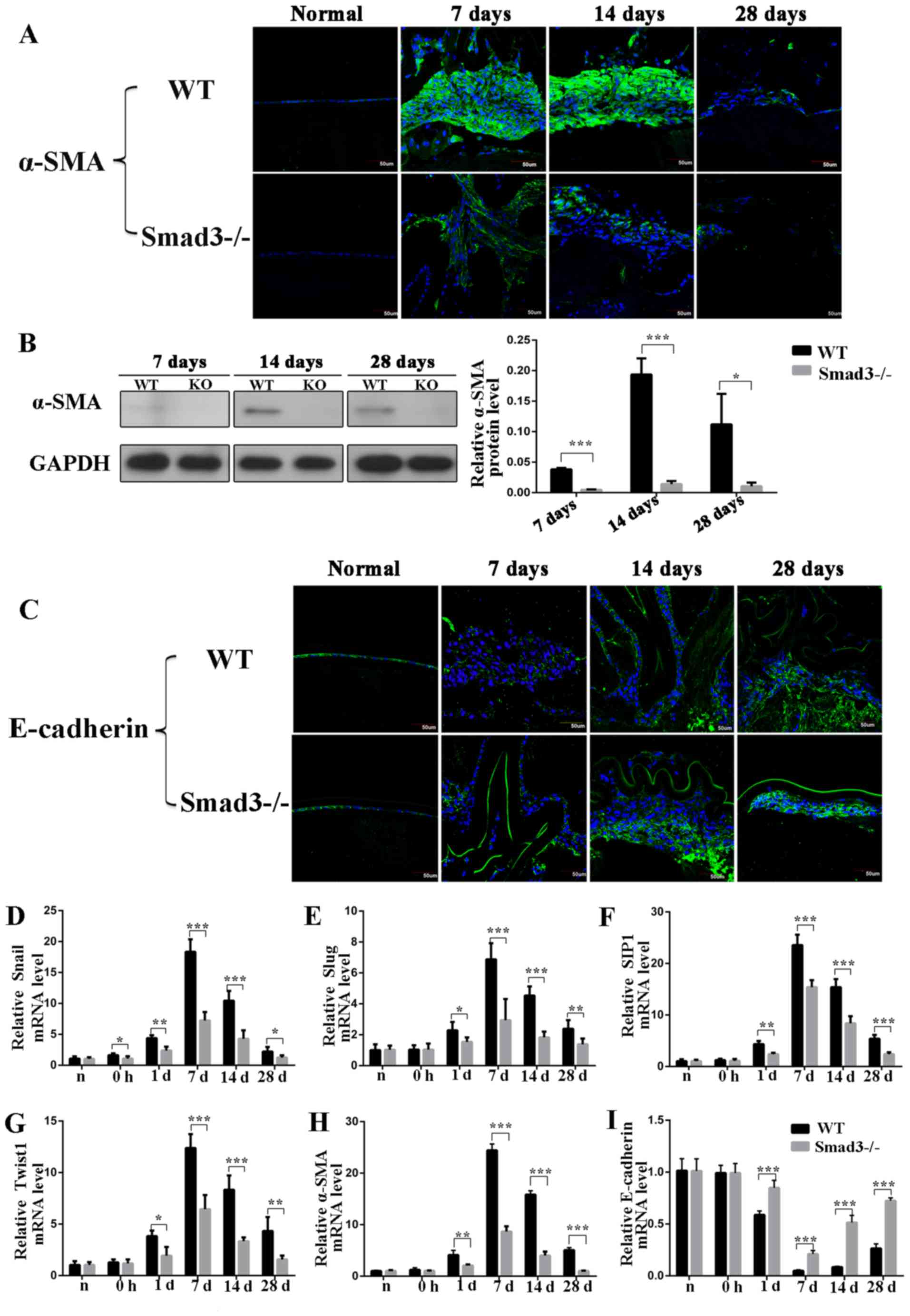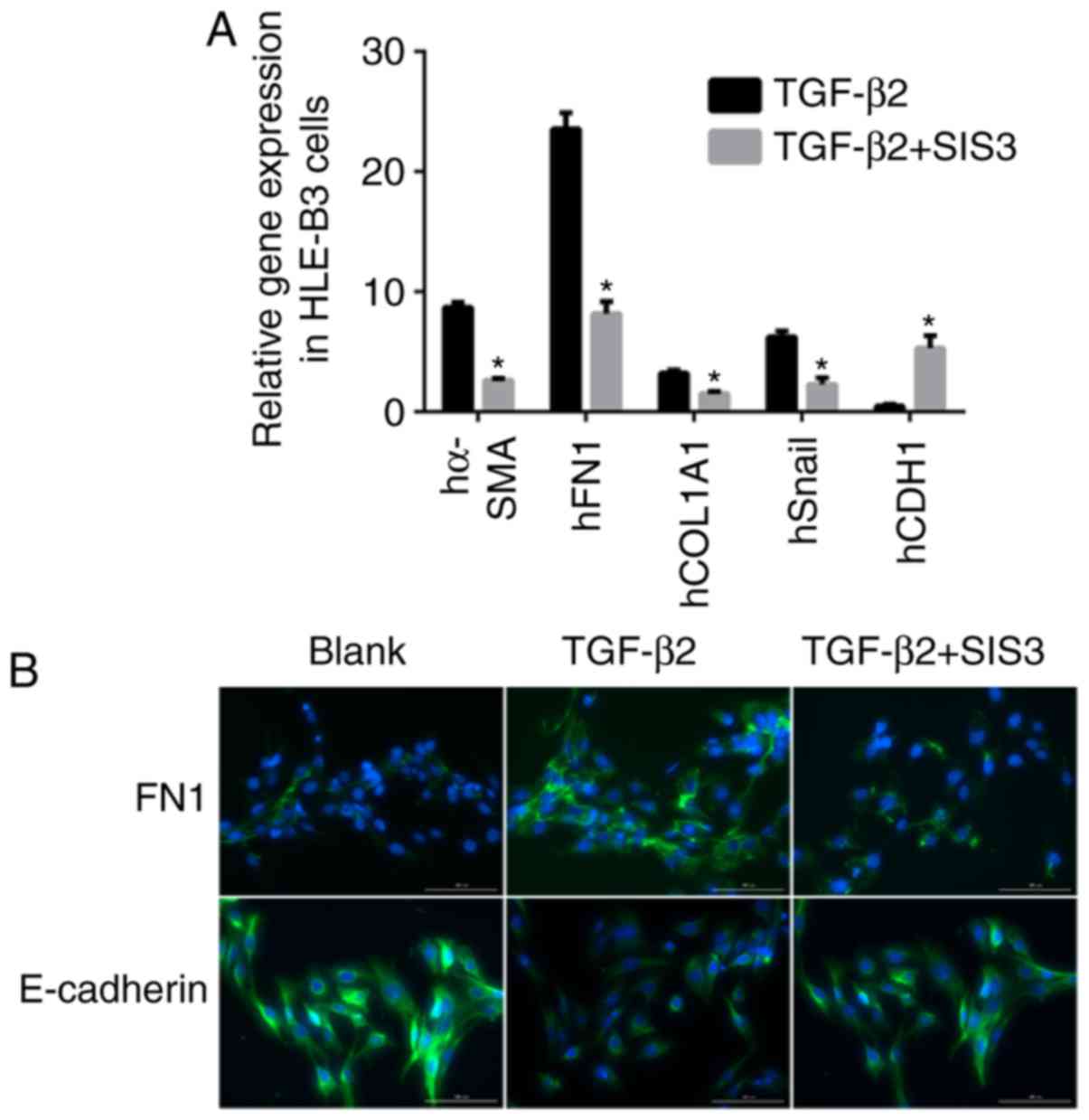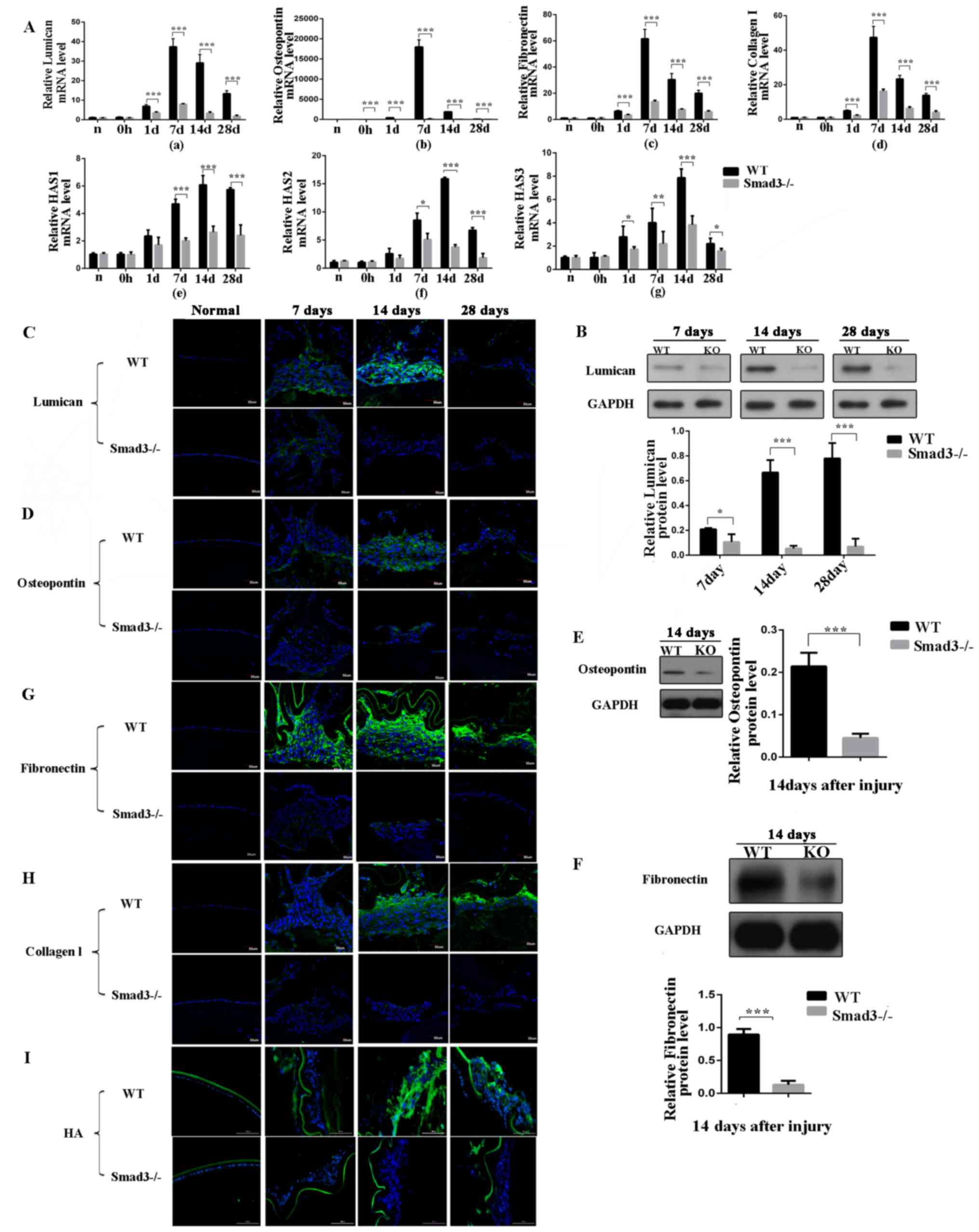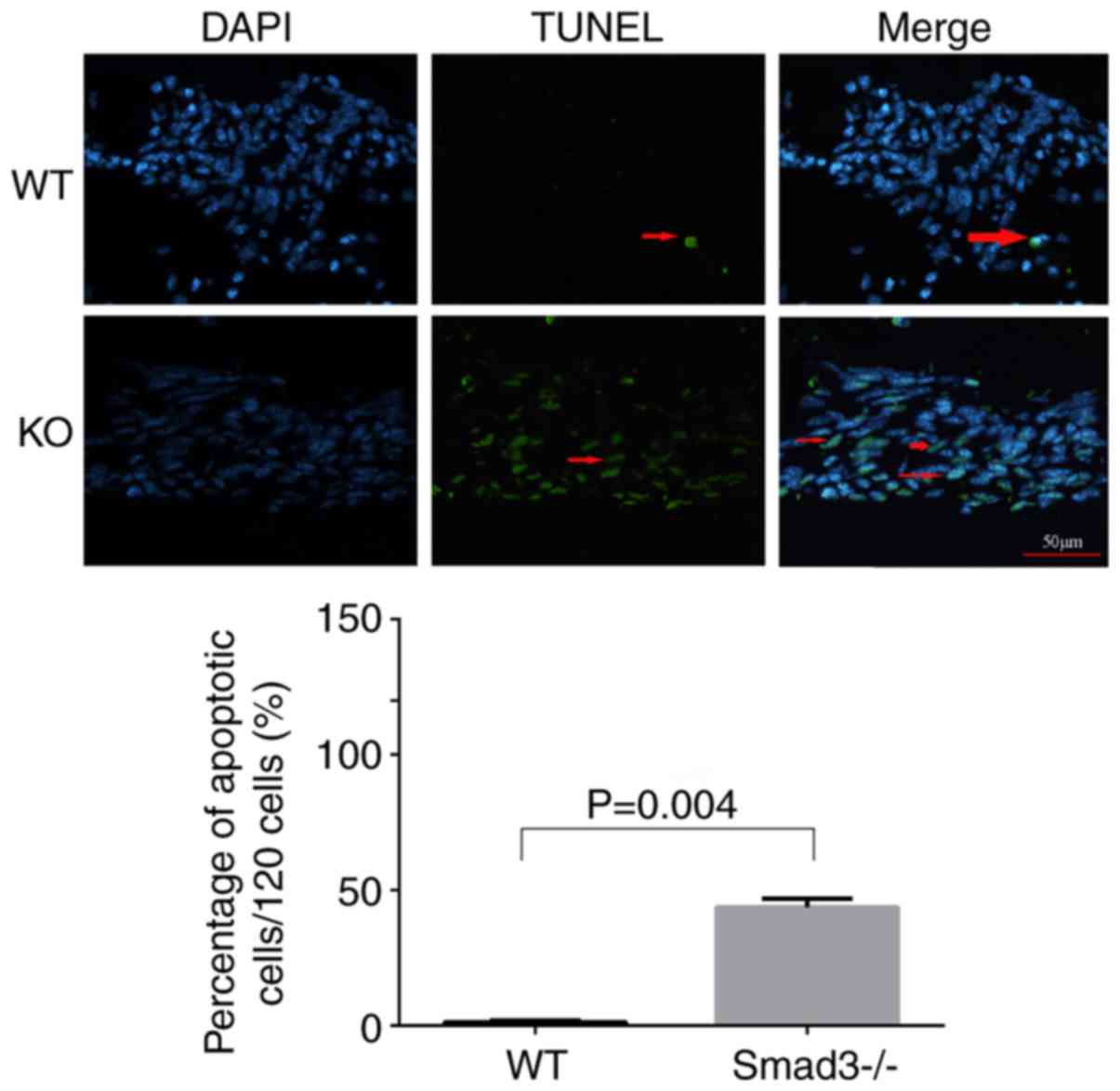|
1
|
Awasthi N, Guo S and Wagner BJ: Posterior
capsular opacification: A problem reduced but not yet eradicated.
Arch Ophthalmol. 127:555–562. 2009. View Article : Google Scholar
|
|
2
|
Nibourg LM, Gelens E, Kuijer R, Hooymans
JM, van Kooten TG and Koopmans SA: Prevention of posterior capsular
opacification. Exp Eye Res. 136:100–115. 2015. View Article : Google Scholar
|
|
3
|
Wallentin N, Wickström K and Lundberg C:
Effect of cataract surgery on aqueous TGF-beta and lens epithelial
cell proliferation. Invest Ophthalmol Vis Sci. 39:1410–1418.
1998.
|
|
4
|
Meacock WR, Spalton DJ and Stanford MR:
Role of cytokines in the pathogenesis of posterior capsule
opacification. Br J Ophthalmol. 84:332–336. 2000. View Article : Google Scholar
|
|
5
|
Lee EH and Joo CK: Role of transforming
growth factor-beta in transdifferentiation and fibrosis of lens
epithelial cells. Invest Ophthalmol Vis Sci. 40:2025–2032.
1999.
|
|
6
|
Chandler HL, Haeussler DJ Jr,
Gemensky-Metzler AJ, Wilkie DA and Lutz EA: Induction of posterior
capsule opacification by hyaluronic acid in an ex vivo model.
Invest Ophthalmol Vis Sci. 53:1835–1845. 2012. View Article : Google Scholar
|
|
7
|
Saika S, Shirai K, Yamanaka O, Miyazaki K,
Okada Y, Kitano A, Flanders KC, Kon S, Uede T, Kao WW, et al: Loss
of osteopontin perturbs the epithelial-mesenchymal transition in an
injured mouse lens epithelium. Lab Invest. 87:130–138. 2007.
View Article : Google Scholar
|
|
8
|
Derynck R and Zhang YE: Smad-dependent and
smad-independent pathways in TGF-beta family signalling. Nature.
425:577–584. 2003. View Article : Google Scholar
|
|
9
|
Uemura M, Swenson ES, Gaca MD, Giordano
FJ, Reiss M and Wells RG: Smad2 and Smad3 play different roles in
rat hepatic stellate cell function and alpha-smooth muscle actin
organization. Mol Biol Cell. 16:4214–4224. 2005. View Article : Google Scholar :
|
|
10
|
Li J, Tang X and Chen X: Comparative
effects of TGF-β2/Smad2 and TGF-β2/Smad3 signaling pathways on
proliferation, migration, and extracellular matrix production in a
human lens cell line. Exp Eye Res. 92:173–179. 2011. View Article : Google Scholar
|
|
11
|
Flanders KC: Smad3 as a mediator of the
fibrotic response. Int J Exp Pathol. 85:47–64. 2004. View Article : Google Scholar
|
|
12
|
Brodeur AC, Roberts-Pilgrim AM, Thompson
KL, Franklin CL and Phillips CL: Transforming growth
factor-β1/Smad3-independent epithelial-mesenchymal transition in
type I collagen glomerulopathy. Int J Nephrol Renovasc Dis.
10:251–259. 2017. View Article : Google Scholar
|
|
13
|
Zhao K, He J, Zhang Y, Xu Z, Xiong H, Gong
R, Li S, Chen S and He F: Activation of FXR protects against renal
fibrosis via suppressing Smad3 expression. Sci Rep. 6:372342016.
View Article : Google Scholar
|
|
14
|
Cho JY, Doshi A, Rosenthal P, Beppu A,
Miller M, Aceves S and Broide D: Smad3-deficient mice have reduced
esophageal fibrosis and angiogenesis in a model of egg-induced
eosinophilic esophagitis. J Pediatr Gastroenterol Nutr. 59:10–16.
2014. View Article : Google Scholar :
|
|
15
|
Wormstone IM, Tamiya S, Eldred JA,
Lazaridis K, Chantry A, Reddan JR, Anderson I and Duncan G:
Characterisation of TGF-beta2 signalling and function in a human
lens cell line. Exp Eye Res. 78:705–714. 2004. View Article : Google Scholar
|
|
16
|
Li H, Yuan X, Li J and Tang X: Implication
of Smad2 and Smad3 in transforming growth factor-β-induced
posterior capsular opacification of human lens epithelial cells.
Curr Eye Res. 40:386–397. 2015. View Article : Google Scholar
|
|
17
|
Saika S, Kono-Saika S, Ohnishi Y, Sato M,
Muragaki Y, Ooshima A, Flanders KC, Yoo J, Anzano M, Liu CY, et al:
Smad3 signaling is required for epithelial-mesenchymal transition
of lens epithelium after injury. Am J Pathol. 164:651–663. 2004.
View Article : Google Scholar
|
|
18
|
Yang X, Letterio JJ, Lechleider RJ, Chen
L, Hayman R, Gu H, Roberts AB and Deng C: Targeted disruption of
SMAD3 results in impaired mucosal immunity and diminished T cell
responsiveness to TGF-beta. EMBO J. 18:1280–1291. 1999. View Article : Google Scholar
|
|
19
|
Xiao W, Chen X, Li W, Ye S, Wang W, Luo L
and Liu Y: Quantitative analysis of injury-induced anterior
subcapsular cataract in the mouse: A model of lens epithelial cells
proliferation and epithelial-mesenchymal transition. Sci Rep.
5:83622015. View Article : Google Scholar
|
|
20
|
Livak KJ and Schmittgen TD: Analysis of
relative gene expression data using real-time quantitative PCR and
the 2(-delta delta C(T)) method. Methods. 25:402–408. 2001.
View Article : Google Scholar
|
|
21
|
Thiery JP, Acloque H, Huang RY and Nieto
MA: Epithelial-mesenchymal transitions in development and disease.
Cell. 139:871–890. 2009. View Article : Google Scholar
|
|
22
|
Yamanaka O, Yuan Y, Coulson-Thomas VJ,
Gesteira TF, Call MK, Zhang Y, Zhang J, Chang SH, Xie C, Liu CY, et
al: Lumican binds ALK5 to promote epithelium wound healing. PloS
One. 8:e827302013. View Article : Google Scholar :
|
|
23
|
Saika S, Miyamoto T, Ishida I, Ohnishi Y
and Ooshima A: Osteopontin: A component of matrix in capsular
opacification and subcapsular cataract. Invest Ophthalmol Vis Sci.
44:1622–1628. 2003. View Article : Google Scholar
|
|
24
|
de Jong-Hesse Y, Kampmeier J, Lang GK and
Lang GE: Effect of extracellular matrix on proliferation and
differentiation of porcine lens epithelial cells. Graefes Arch Clin
Exp Ophthalmol. 243:695–700. 2005. View Article : Google Scholar
|
|
25
|
Banh A, Deschamps PA, Gauldie J, Overbeek
PA, Sivak JG and West-Mays JA: Lens-specific expression of TGF-beta
induces anterior subcapsular cataract formation in the absence of
Smad3. Invest Ophthalmol Vis Sci. 47:3450–3460. 2006. View Article : Google Scholar
|
|
26
|
Toole BP, Wight TN and Tammi MI:
Hyaluronan-cell interactions in cancer and vascular disease. J Biol
Chem. 277:4593–4596. 2002. View Article : Google Scholar
|
|
27
|
Saika S, Miyamoto T, Ishida I, Ohnishi Y
and Ooshima A: Lens epithelial cell death after cataract surgery. J
Cataract Refract Surg. 28:1452–1456. 2002. View Article : Google Scholar
|
|
28
|
van Roy F and Berx G: The cell-cell
adhesion molecule E-cadherin. Cell Mol Life Sci. 65:3756–3788.
2008. View Article : Google Scholar
|
|
29
|
Vincent T, Neve EP, Johnson JR, Kukalev A,
Rojo F, Albanell J, Pietras K, Virtanen I, Philipson L, Leopold PL,
et al: A SNAIL1 SMAD3/4 transcriptional repressor complex promotes
TGF-beta mediated epithelial-mesenchymal transition. Nat Cell Biol.
11:943–950. 2009. View
Article : Google Scholar
|
|
30
|
Postigo AA, Depp JL, Taylor JJ and Kroll
KL: Regulation of Smad signaling through a differential recruitment
of coactivators and corepressors by ZEB proteins. EMBO J.
22:2453–2462. 2003. View Article : Google Scholar :
|
|
31
|
Postigo AA: Opposing functions of ZEB
proteins in the regulation of the TGFbeta/BMP signaling pathway.
EMBO J. 22:2443–2452. 2003. View Article : Google Scholar
|
|
32
|
Chen ZF and Behringer RR: Twist is
required in head mesenchyme for cranial neural tube morphogenesis.
Genes Dev. 9:686–699. 1995. View Article : Google Scholar
|
|
33
|
Choi K, Lee K, Ryu SW, Im M, Kook KH and
Choi C: Pirfenidone inhibits transforming growth factor-β1-induced
fibrogenesis by blocking nuclear translocation of Smads in human
retinal pigment epithelial cell line ARPE-19. Mol Vis.
18:1010–1020. 2012.
|
|
34
|
Polydorou C, Mpekris F, Papageorgis P,
Voutouri C and Stylianopoulos T: Pirfenidone normalizes the tumor
microenvironment to improve chemotherapy. Oncotarget.
8:24506–24517. 2017. View Article : Google Scholar :
|
|
35
|
Papageorgis P, Polydorou C, Mpekris F,
Voutouri C, Agathokleous E, Kapnissi-Christodoulou CP and
Stylianopoulos T: Tranilast-induced stress alleviation in solid
tumors improves the efficacy of chemo- and nanotherapeutics in a
size-independent manner. Sci Rep. 7:461402017. View Article : Google Scholar :
|
|
36
|
Kaneyama T, Kobayashi S, Aoyagi D and
Ehara T: Tranilast modulates fibrosis, epithelial-mesenchymal
transition and peritubular capillary injury in unilateral ureteral
obstruction rats. Pathology. 42:564–573. 2010. View Article : Google Scholar
|
|
37
|
Robertson JV, Nathu Z, Najjar A, Dwivedi
D, Gauldie J and West-Mays JA: Adenoviral gene transfer of
bioactive TGFbeta1 to the rodent eye as a novel model for anterior
subcapsular cataract. Mol Vis. 13:457–469. 2007.
|
|
38
|
Pervan CL: Smad-independent TGF-β2
signaling pathways in human trabecular meshwork cells. Exp Eye Res.
158:137–145. 2017. View Article : Google Scholar
|
|
39
|
Secker GA, Shortt AJ, Sampson E, Schwarz
QP, Schultz GS and Daniels JT: TGFbeta stimulated
re-epithelialisation is regulated by CTGF and Ras/MEK/ERK
signalling. Exp Cell Res. 314:131–142. 2008. View Article : Google Scholar
|
|
40
|
Bakin AV, Tomlinson AK, Bhowmick NA, Moses
HL and Arteaga CL: Phosphatidylinositol 3-kinase function is
required for transforming growth factor beta-mediated epithelial to
mesenchymal transition and cell migration. J Biol Chem.
275:36803–36810. 2000. View Article : Google Scholar
|
|
41
|
Bhowmick NA, Ghiassi M, Bakin A, Aakre M,
Lundquist CA, Engel ME, Arteaga CL and Moses HL: Transforming
growth factor-beta1 mediates epithelial to mesenchymal
transdifferentiation through a RhoA-dependent mechanism. Mol Biol
Cell. 12:27–36. 2001. View Article : Google Scholar :
|
|
42
|
Bhowmick NA, Zent R, Ghiassi M, McDonnell
M and Moses HL: Integrin beta 1 signaling is necessary for
transforming growth factor-beta activation of 38MAPK and epithelial
plasticity. J Biol Chem. 276:46707–46713. 2001. View Article : Google Scholar
|
|
43
|
Shirai K, Saika S, Tanaka T, Okada Y,
Flanders KC, Ooshima A and Ohnishi Y: A new model of anterior
subcapsular cataract: Involvement of TGFbeta/Smad signaling. Mol
Vis. 12:681–691. 2006.
|
|
44
|
de Iongh RU, Wederell E, Lovicu FJ and
McAvoy JW: Transforming growth factor-beta-induced
epithelial-mesenchymal transition in the lens: A model for cataract
formation. Cells Tissues Organs. 179:43–55. 2005. View Article : Google Scholar
|
|
45
|
Chen X, Xiao W, Chen W, Luo L, Ye S and
Liu Y: The epigenetic modifier trichostatin A, a histone
deacetylase inhibitor, suppresses proliferation and
epithelial-mesenchymal transition of lens epithelial cells. Cell
Death Dis. 4:e8842013. View Article : Google Scholar
|
|
46
|
Liu K, Gao Z, Wu X, Zhou G, Zhang WJ, Yang
X and Liu W: Knocking out Smad3 favors allogeneic mouse fetal skin
development in adult wounds. Wound Repair Regen. 22:265–271. 2014.
View Article : Google Scholar
|
|
47
|
McDowell CM, Tebow HE, Wordinger RJ and
Clark AF: Smad3 is necessary for transforming growth factor-beta2
induced ocular hypertension in mice. Exp Eye Res. 116:419–423.
2013. View Article : Google Scholar
|
|
48
|
Maruno KA, Lovicu FJ, Chamberlain CG and
McAvoy JW: Apoptosis is a feature of TGF beta-induced cataract.
Clin Exp Optom. 85:76–82. 2002. View Article : Google Scholar
|
|
49
|
Lee JH, Wan XH, Song J, Kang JJ, Chung WS,
Lee EH and Kim EK: TGF-beta-induced apoptosis and reduction of
Bcl-2 in human lens epithelial cells in vitro. Curr Eye Res.
25:147–153. 2002. View Article : Google Scholar
|
|
50
|
Edlin RS, Tsai S, Yamanouchi D, Wang C,
Liu B and Kent KC: Characterization of primary and restenotic
atherosclerotic plaque from the superficial femoral artery:
Potential role of Smad3 in regulation of SMC proliferation. J Vasc
Surg. 49:1289–1295. 2009. View Article : Google Scholar
|
|
51
|
Tapia-González S, Muñoz MD, Cuartero MI
and Sanchez-Capelo A: Smad3 is required for the survival of
proliferative intermediate progenitor cells in the dentate gyrus of
adult mice. Cell Commun Signal. 11:932013. View Article : Google Scholar
|


















